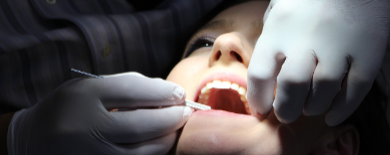How can you tell if you are hitting the mark when it comes to good oral care? Generally your teeth and gums should not be painful, feel rough or sharp to your tongue, or bleed. Your breath should be fresh for at least a couple of hours after brushing. The best measure of how well you are doing is what your hygienist and dentist report to you at your checkups.
Based upon how much plaque has hardened to form tartar, your dentist or dental hygienist will let you know what you need to work on and can offer suggestions on how to do a better job of cleaning your teeth. One of the easiest ways to prevent oral problems is to clean your teeth properly, so try these tricks for a healthier mouth.ervices for cross-media e-services.
1. Rinse your mouth. If you use a mouthwash twice a day you will slash your risk of gum disease by 60%. Ideally you should aim to rinse for about 30 seconds with a mouthwash with microbial protection to fight plaque and gingivitis. Ask your dentist or hygienist for a recommendation on the right mouthwash for you.
2. Floss first. Brushing daily is great, but if you don’t also floss, you are leaving 40% of your tooth surface untouched. Start with an 18-inch piece of floss and move to a fresh bit of string for each new tooth you clean so you do not move plaque around your mouth from tooth to tooth. Slide the floss around the tooth edge and glide up and down along the tooth surface. Floss before you brush rather than after so that the brushing will remove any food that was stuck between your teeth to prevent bacteria from growing. There are many different kinds of floss–waxed, non-waxed, flavored, tape, thick or thin. There are floss-threaders, floss holders, even long-handled ergonomic ones to make flossing back teeth an easy reach. There are also interdental tools with tiny brushes or soft picks that slip into spaces between teeth along the gumline to remove plaque. We suggest that you try out several types until you find the one you like the best. If you are happy with the floss or the tool you select, you are more likely to use it!
3. Get the right toothbrush. If you have been in a drug store you know there are a variety of brushes to choose from. Soft or extra soft bristles are the best. If you use medium or hard-bristled brushes, you can scratch the gum tissue away over time, exposing the root surface underneath, leading to possible bone loss. If you have a small mouth, select a toothbrush with a small brush head. If you have arthritis or if an injury has weakened your grip, a fat handle may be easier to maneuver. There are even specialty brushes for braces. We recommend an electric toothbrush. A brush with an oscillating, rotating power brush is better at plaque removal than a side-to-side vibrating one.
4. Brush smart. To really clean your teeth and gums, you should aim to brush for a full 2 minutes at least twice a day with a pea-sized amount of fluoride toothpaste. (With children, sing “Happy Birthday” or the alphabet song twice through at normal speed for each half of their mouth.) Make sure one of the times you brush is before bed to remove as much bacteria as possible before you sleep. Use a light touch when you brush. Brushing too hard can damage teeth and gums. Hold your toothbrush at a 45-degree angle, and use small, circular strokes to gently remove plaque along the gumline of your inner and outer tooth surfaces. To clean chewing surfaces, use back-and-forth strokes. Give your tongue a few swipes too, to help prevent bad breath. Be sure to check the wear of your bristles and replace your toothbrush every 3 to 4 months, or sooner if the bristles look worn or frayed. It is also a good idea to replace the brush after any illness.
To help keep your teeth in tip-top shape, see your dental hygienist twice a year for a cleaning. Even if you are a top-notch brusher and flosser, you still need professional cleanings to remove tartar buildup with a process called scaling. Your hygienist will also polish your teeth and remove stains to help prevent future plaque buildup, cavities and gum disease. With a bit of practice, taking care of your pearly whites will become a piece of cake!


